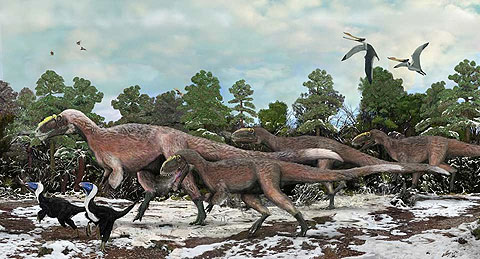|
Researchers Unearth Largest Feathered Dinosaur
 |
Strutting the plumes. Yutyrannus huali, the largest known feathered creature (several individuals depicted running at center and right), measured about 9 meters long as an adult and probably weighed more than 1,400 kilograms.
Credit: Brian Choo
|
Paleontologists have unearthed fossils of the largest feathered creature yet known, a 1.4-metric-ton dinosaur that was an early cousin of Tyrannosaurus rex. The long, filament-like feathers preserved with three relatively complete skeletons of the newly described species provide direct evidence of extensively feathered gigantic dinosaurs. The discovery is controversial—and in some scientific circles, largely unexpected.
The species, dubbed Yutyrannus huali (a blend of Latin and Mandarin that means "beautiful feathered tyrant"), lived in what is now northeastern China about 125 million years ago. Y. huali was a theropod, a type of dinosaur that, with very few exceptions, preyed on other creatures.T. rex, which lived in what is now North America between 68 million and 65 million years ago, was also a theropod but not a direct descendent of Y. huali.
The largest of the Yutyrannus skeletons--found in China's Liaoning province in rocks of an era famed for its feathered dinosaurs—represents an adult that in life would have measured about 9 meters long, or slightly shorter than a school bus. Because the other individuals were smaller, and because pieces of some of their vertebrae hadn't fully fused, those creatures are presumed to be juveniles, says Xing Xu, a paleontologist at the Institute of Vertebrate Paleontology and Paleoanthropology in Beijing. They tipped the scales at around a half-ton each. Full grown, Y. huali likely weighed more than 1400 kilograms, or 1.4 metric tons. The previous record holder for heftiest feathered dinosaur—Beipiaosaurus, a creature that most probably lived alongside Y. huali—weighed only one-fortieth as much. T. rex was not known to be feathered, but as an adult grew to reach lengths exceeding 12 meters and weights above 6.5 metric tons.
All three Y. huali specimens sported filament-like feathers at least 15 centimeters long. In the adult, those structures appeared along the end of its tail; in the juveniles, the feathers appeared along the neck and upper arm in one individual and near the pelvis and foot in the other. Although the preservation is patchy in each of the individuals, together the diverse areas swathed in filaments suggest that members of the species were extensively covered with feathers, Xu and his colleagues report online today in Nature.
The new finding "shows for the first time that that even giant theropods could be plumaged, and likely fully plumaged," says Richard Prum, an evolutionary ornithologist at Yale University.
On dinosaurs, as on modern birds, feathers could have served a variety of purposes, providing lift or maneuverability during flight; a means of sending signals to other members of its species, including those of the opposite sex; or insulating against the cold.
In Y. huali, however, the type of feather—and the creature's immense weight—indicates that flight was out of the question. And unless the filaments were variably colored, an aspect that Xu and his colleagues are now studying but haven't yet determined, intraspecies signaling can't be presumed. Previously, says Xu, most scientists presumed that large dinosaurs—like many of today's large animals, such as elephants and rhinos—didn't need insulation because their immense bulk helped them efficiently maintain body heat.
But because so many small theropods discovered in recent years have been feathered, the possibility of plumage on larger dinosaurs such as T. rex has been hotly debated. In that sense, the discovery of feathers on a creature the size of Y. huali is very unexpected, even controversial. But the team's measurements of the oxygen isotope ratios in the creatures' teeth, a sensitive paleo-thermometer, suggest that the climate where these dinosaurs lived probably averaged about 10° Celsius over the course of a year—substantially colder than most of the dinosaur era, and in fact close to that seen in northeastern China today, Xu notes.
Regardless of the feathers' function, the researchers say, the new discovery reveals that a drastic reduction in plumage wasn't an inevitable consequence of very large body size.
The team's findings "are another good example of evolution being a predictive science," says Thomas Holtz, Jr., a vertebrate paleontologist at the University of Maryland in College Park. Because many species of small-bodied theropods unearthed since the 1990s had been feathered, many researchers suggested that larger species of tyrannosaurs and their close kin could have feathers, as well, he notes. "We've just never had any positive information one way or the other before."
Source: ScienceNOW
04/04/2012
|